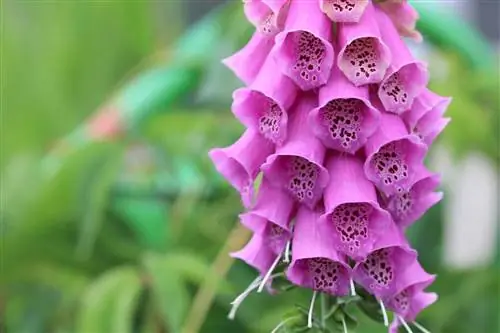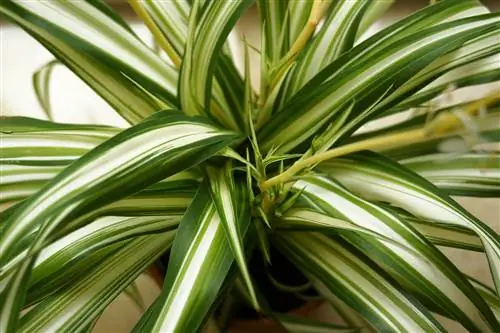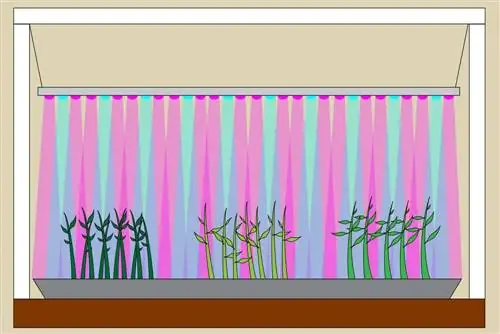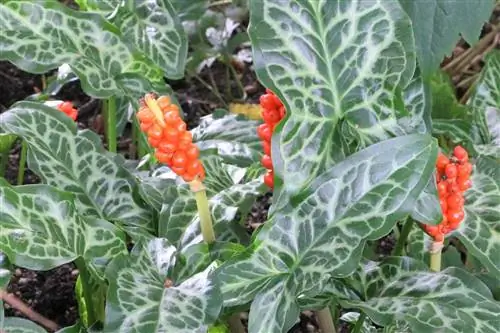- Author admin [email protected].
- Public 2023-12-17 03:39.
- Last modified 2025-01-24 12:45.
The foxglove is a plant with two faces. On the one hand, the Digitalis purpurea presents itself as a decorative plant with eye-catching and fascinating flowers. The color spectrum is diverse, everything from pink, red, white, yellow and purple is represented. On the other hand, the plantain plant is considered extremely poisonous. The plant, also known as the forest bell or pasque flower, has been used for centuries in folk medicine for heart problems. Even if self-medication is strongly discouraged, the plant still offers a striking eye-catcher in the garden.
Location and soil
Digitalis purpurea is a deadly beauty that many gardeners have mixed feelings about. The plant with its upright, tall growth and eye-catching flowers is rarely found in the wild. In the past, foxgloves could often be encountered in open forests and wild meadows. For successful cultivation in your own garden, you should choose a sunny location. But the foxglove also feels at home under large trees, in partial shade, and produces its colorful flowers. Tip: Plant poisonous plants out of the reach of small children and frolicking pets. Even a small dose of foxglove can require a visit to the emergency room. The plant, which belongs to the plantain family, reacts sensitively to calcareous soils. You are much more likely to promote the growth and resistance of Digitalis purpurea with a deep, humus-rich and slightly acidic substrate. If you have a sufficiently large planter, you can also keep the foxglove in a pot.
Watering and fertilizing
Another important criterion for the successful cultivation of this distinctive beauty is a moist substrate. However, waterlogging also puts unnecessary strain on the plant. Therefore, water the foxglove moderately, but at regular intervals, with lime-free water. On hot summer days this may be necessary twice a day. You can protect the soil from drying out too quickly with a thick layer of bark mulch. Alternatively, you can use a special fleece from a specialist store for this task. If the forest bells were planted directly in the bed, it is sufficient if you enrich the soil with compost twice a year. The first fertilization takes place between the end of February and mid-March, the second time in August. Work the material carefully into the soil. This measure not only loosens up the soil, but also removes moss and annoying weeds. If you don't have a compost heap in your garden or you don't want to use this method for another reason, you can also use conventional liquid fertilizer. The product is administered directly via the irrigation water every 4 to 6 weeks, which ensures even distribution in the substrate.
Sowing and planting
The foxglove only forms a basal leaf rosette in the first year. The impressive flowers only appear the following year on a stem that is up to 200 cm high. Even though the plant usually doesn't live longer than two years, it is still extremely prolific. If the plant feels comfortable in the selected location, it will grow itself. However, you can also carry out sowing in spring or summer in a controlled manner. Use a shallow cultivation container until the plants are strong enough to be transplanted outdoors.
- The location should be bright, but not sunny.
- Cover the fine seeds only lightly with lean substrate.
- Keep the soil evenly moist with a water sprayer.
- A perforated, transparent film increases the humidity.
- Remove the film for a few hours a day to allow air circulation.
ThePlanting out takes place as soon as the young plants have reached a height of around 10 cm, but no later than mid-September. Be careful not to damage the taproots of the plants. Foxgloves look particularly good when planted in groups. For example, combine ferns, blue woodruff, willowherb or various cranesbill species together with Digitalis purpurea. When planting in the bed, proceed as follows:
- Remove wilted plants and root remains from the site.
- Mix soil with humus.
- The planting hole should have twice the circumference of the foxglove root ball.
- Loose up the surrounding soil too.
- Insert plants.
- When planting in rows, maintain a minimum distance of around 25 cm.
Water the young plants firmly. By the time the first frost sets in, the plants should have already established themselves in the new planting location. However, to be on the safe side, you can also spread a thick layer of bark mulch, brushwood or compost.
Propagate
The impressive plant is only propagated via the dusty seeds, which form after flowering in autumn. As soon as the seed pods turn brown and break open at the top, you can carefully pour out the seeds. Unlike many other native plant species, foxglove does not require stratification. Theoretically you can sow directly on site. If you don't want to use the seeds until the following year, let the fine seeds dry in a dark, not too humid place.

Cutting
By removing wilted inflorescences, you can encourage the red foxglove to produce a second flower. The seed capsules also ripen on the separated shoots and can be used for targeted and controlled sowing. Important: Digitalis purpurea was named poisonous plant of the year in 2007. If you come into direct contact with the plants, use gloves and do not bring any of the plant parts into contact with the mucous membranes.
Wintering
You don't have to take any special precautions for the cold season. The freezing temperatures even have a positive effect on flowering. The frostier it is, the more lush the foxglove blooms the following year. However, things look a little different when cultivating in planters. At double-digit minus temperatures there is a risk that the substrate in the pot will freeze completely and the roots will be damaged. Therefore, wrap the vessel over a large area with burlap or a special fleece. From October to March you should avoid watering or adding fertilizer.
Conclusion of the editors
The foxglove is a decorative plant that brings variety to the garden with a wide range of colors. The plant itself places few demands on the hobby gardener. Under no circumstances should Digitalis purpurea be planted in the immediate vicinity of children or pets, as eating just two leaves can lead to death. However, with the necessary precautionary measures, the poisonous plants can also shine in their full splendor in family gardens.
Things worth knowing about the foxglove in brief
Profile
- Species/Family: Perennial. Belongs to the figwort family (Scrophulariaceae)
- Care effort: Low. Short-lived, but spreads on its own and becomes a permanent guest
- Flowering time: June to August with large, bell-shaped individual flowers sitting close to long flower candles in purple, red, pink, yellow or white with characteristic dark spots in the flowers
- Foliage: Wintergreen. Narrow, elongated to ovoid, dark green leaves
- Growth: Upright with rosette formation of leaves. Spreads through insemination alone when he feels comfortable
- Ingredients: Cardenolides, therefore toxic
- Height/width: 90 to 150 cm high, 40 to 60 cm wide
- Location: Partly shaded, can also tolerate sun. Prefers places in front of and between deep-rooted trees. Humus-rich, rather dry soil
- Planting time: Any time as long as the ground is not frozen. Can be grown from seeds directly outdoors in July-August (germination time 15-25 days at 18-22 °C)
- Cut: Close to the ground after flowering if self-sowing is not desired. Otherwise cut back after the seed capsules have ripened and sowed
- Partner: Work beautifully in group plantings. Forest grasses, ferns, tall bluebell, goat's beard, silver candle
- Propagation: Seeds can be collected
- Care: Lifespan is extended if spent flower stalks are cut away
- Wintering: Frost hardy. Seeds overwinter and mature the following year
Special features
- Flowers attract bumblebees and bees
- fits very well in the natural garden or in heath gardens
Species
- Yellow foxglove (Digitalis lutea): impresses with lemon-yellow flowers; loves calcareous soil; Rarely found species
- Red foxglove (Digitalis purpurea): height 90-150 cm, 40-60 cm wide; blooms from June to August with large, bell-shaped individual flowers close to long flower candles in purple-red, pink, yellow or white; prefers dry soil, but also tolerates moisture well; but sensitive to limescale; look beautiful in group plantings: forest grasses, ferns, tall bluebells, goat's beard, silver candle
Varieties (selection)
- `Comte de Chambord: Blooms in rose-pink colors; goes very well with the pink climbing rose 'Raubrittard
- `Excelsior: Red Foxglove; Flower colors in purple, pink and white on one plant
- `Gloxiniaeflora: Red Foxglove; well-known variety with flower bells in purple-pink
- `Gloxiniaeflora Alba: Red Foxglove; also known with white flowers
- `Sutton's Apricot: Red Foxglove; extraordinary salmon pink flowers






